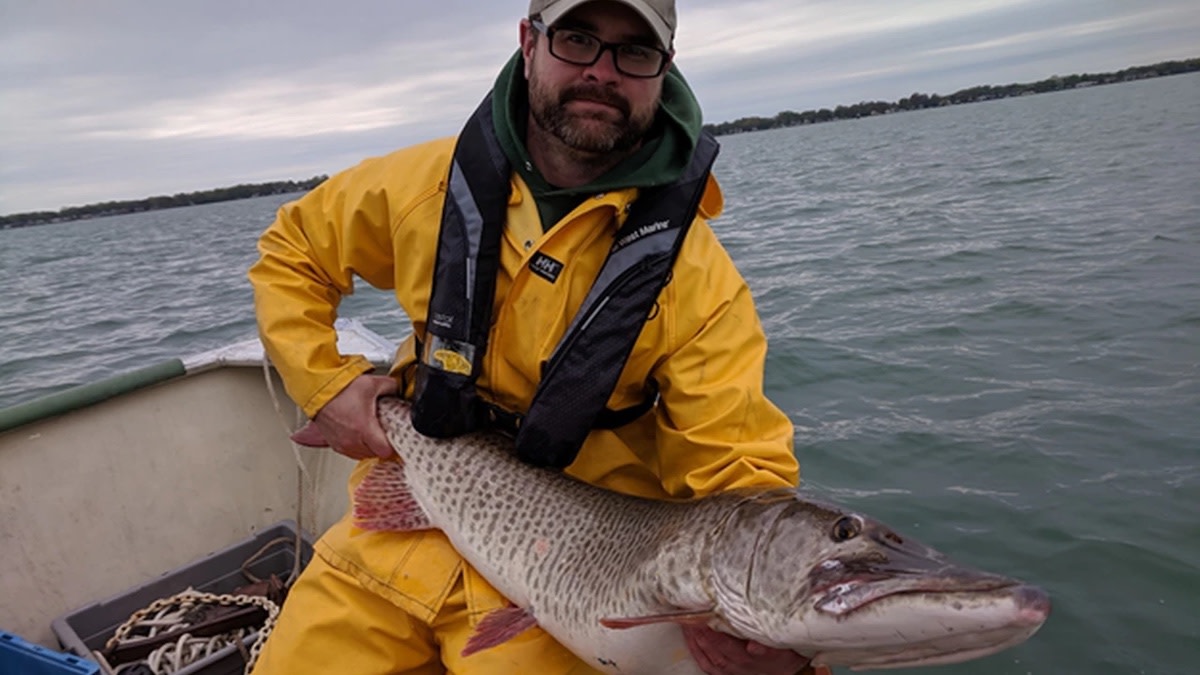
This article comes from the Bent Fishing Podcast’s “Fish News” segment, where hosts Joe Cermele and Miles Nolte go head-to-head to find and report the most interesting and amusing fishy stories across sources far and wide—from respected scientific journals to trashy tabloids.
The Michigan Department of Natural Resources tagged a muskellunge in the Detroit River in May 2016 with tag number 007. Understandably, the muskie acquired a name to match the tag: Bond, James Bond.
Muskies are a mysterious (and for some, mythical) fish. These toothy freshwater predators can reach massive sizes, their elusive behaviour makes some folks completely dedicate their lives to their pursuit, and the challenge of actually landing them sparks serious obsession among anglers. But we haven’t really known much about how these commendable catches spend their time beyond hook and line until recently.
The Minnesota DNR partnered with the Ontario Ministry of Natural Resources and Forestry, Ohio DNR, and United States Geological Survey to track James and 110 other muskellunge across the Great Lakes region via acoustic telemetry.
According to the study “Seasonal movements of muskellunge in the St. Clair–Detroit River System: Implications for multi-jurisdictional fisheries management,” James traveled from his original tagging location in Detroit, Michigan, all the way across Lake Erie to Buffalo, New York, in the summer of 2016. By January 2017, James was back in Michigan waters, and in May 2017 he was only a few hundred yards from where he had been captured the year before. He made the remarkable journey of at least 620 miles within a year.
“This is a unique fish,” Stephen Marklevitz, an Ontario Ministry of Natural Resources and Forestry biologist involved in the study, told Michigan Live. “Most of our fish in the study aren’t traveling this far.”
James made a very similar trip again in 2018 and 2019. The study authors wrote that the most significant lesson they learned from recording the movement patterns of these fish is that “large predatory fish are migrating long distances at relatively high swim speeds and are showing seasonality and repeatability in their movement patterns.”
James might have traveled the furthest in the study, but he was not a complete outlier. In fact, 9% of the sampled fish traveled over a mile per day, and 28% of the tagged population demonstrated seasonal large-scale movement to and from the bigger Lake Erie from their original tagging locations.
The researchers hypothesize that the seasonal movement patterns are not associated with spawning but with feeding. Large runs of shad in the Thames and Belle rivers, for example, could be bringing these transient predators back from deeper waters year after year.
This study relied on the Great Lakes Acoustic Telemetry Observation System (GLATOS) to track the fish. According to its website, GLATOS was established by the Great Lakes Fishery Commision to “understand fish behavior in relation to Great Lakes ecology and provide useful information to fish managers in their decision making.” This system uses acoustic telemetry, which involves surgically implanting tags in fish that transmit unique acoustic signals. Receivers stationed throughout the Great Lakes pick up these signals, decode them, and record the data with a date and time stamp.
GLATOS hosts a number of fishery studies. Current research focuses heavily on popular game species like sturgeon and walleye but also include carp, brook trout, burbot, and whitefish. The scientific publications deriving from this research span a decade, providing indispensable information for fisheries management.
“It’s pretty exciting to start unlocking some of the mysteries of muskies,” Marklevitz said. “That’s one of the coolest things we’ve seen. We never thought a muskie would have migrated the entire length of Lake Erie and had such a diversity in movement patterns.”
For more Fish News and so much more, listen to the Bent Podcast and sign up for our brand-new Fishing Weekly Newsletter!
Feature image via Minnesota DNR.




